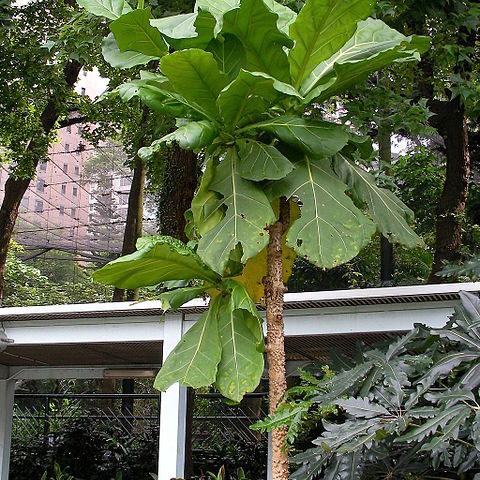Terrestrial, epiphytic, or hemi-epiphytic, often scrambling shrubs, woody climbers, or small to fairly large trees, glabrous in all parts. Stipules connate into an ocrea which usually early splits (interpetiolarly) into 2 axillary scales, these free or partly to entirely adnate to the base of the petiole; axillary colleters all around the node. Leaves petioled or sometimes sessile, coriaceous or more or less fleshy, nearly always entire (crenulate in F. crenulata), base usually decurrent and sometimes auriculate; penninerved, nerves often, veins nearly always inconspicuous to invisible. Flowers solitary, in twos, or in 3-to many-flowered cymose (rarely glomerulous, thyrsoid, or by reduction racemose or spicate) inflorescences, nearly always terminal, usually with a pair of strong basal branches in the upper leaf-axils; peduncle nearly always quadrangular in section, slightly compressed, sometimes terete, branches usually distinctly compressed. Bracts (except lower ones) small and scale-like. Bracteoles usually present, mostly similar to the bracts, but smaller, in some species large and enveloping the calyx, in that case often 2(-3) pairs present (Fig. 21). Calyx thick-fleshy to coriaceous, in some species even almost woody, lobes imbricate, nearly always rounded, thick with a thin margin, inside with colleters at the base. Corolla fleshy, sometimes very thick, creamy-white (outside sometimes greenish or pinkish), the second day turning to yellow or orange, tube consisting of a tubular, thin (ner)-walled basal part which may be very short and included in the calyx but can form the greater part of the tube, and a thicker-walled upper part which is either tubular and only slightly widened towards the mouth, or narrowly to widely funnel-shaped; lobes contorted, overlapping to the right, variable in length but always shorter than the tube, rounded. Stamens inserted in the throat (between the basal and the upper part of the tube), in some species on a thickened ring (Fig. 23b); filaments broadened at and geniculate just above the base, strap-shaped, sometimes filiform; anthers basifixed, either deeply bifid at the base and blunt-ellipsoid, or shallowly bifid and acute-linear; cells dehiscing lengthwise, introrse. Ovary ellipsoid, tapering into a filiform to cylindric (in sicco deeply lengthwise grooved) style about as long as the tube or distinctly exserted; stigma capitate, obconical, peltate, or 2-lobed; ovary either 1-celled with 2 parietal placentas, or 2-celled with axile placentas; placentas peltate, elliptic, with ∞ ovules. Fruit: berry, but in some large-fruited species 4-valved; usually globular to ellipsoid, crowned by the style-base, pale greyish-green or whitish or turning via yellow and orange to bright red; under the epidermis with a sticky white latex; calyx not or slightly enlarged (caducous in some forms of F. blumei). Seeds ∞, irregularly angular, c. 1 mm long, minutely warty, brown.
More
Terrestrial to epiphytic woody climbers, scrambling shrubs or trees, glabrous. Leaves usually petiolate; stipules connate, forming a collar around branchlet, usually splitting into 2 axillary scales which are free to adnate to petiole base; lamina entire, coriaceous to fleshy, penninerved. Inflorescence a modified cyme, usually terminal, few-to many-flowered; bracts small; bracteoles present (sometimes, not in Australia, absent). Flowers 5-merous. Calyx coriaceous to fleshy; lobes imbricate, thick with thin margin. Corolla fleshy, narrowly to widely funnel-shaped; lobes contorted, overlapping, shorter than tube, rounded. Stamens sometimes inserted on thickened ring; filaments broadened and geniculate near base; anthers basifixed. Ovary superior, ellipsoidal; stigma capitate, obconical, peltate or bilobed. Fruit berry-like, with white sticky latex present under epidermis; base of style persistent. Seeds numerous, irregularly angular, c. 1 mm long, minutely warty, brown.
Trees or shrubs, sometimes scandent, epiphytic or semi-epiphytic. Leaves petiolate or sometimes sessile; stipules connate into an ocrea which usually splits early into 2 axillary scales; leaf blade margin entire or rarely crenulate, veins often inconspicuous. Flowers terminal or axillary, solitary or in cymes forming racemes, corymbs, or panicles, 5-merous, large. Calyx deeply divided; lobes broad, thick, imbricate, base inside with colleters. Corolla funnelform to salverform, with a long tube; lobes shorter than tube, contorted, overlapping to right in bud. Stamens inserted at or near corolla mouth, often exserted; filaments filiform; anthers introrse. Ovary 1-locular with parietal placentation or 2-locular with axillary placentation, with many ovules per locule. Style filiform to thick; stigma capitate, obconical, peltate, or 2-cleft. Berries globose to ellipsoid, 1-or 2-locular, many-seeded. Endosperm horny.
Mostly heliophilous plants, along forest edges, on river-banks, in open places, also shrubs or trees in light forest and savannahs; from sea-level up to c. 3000 m. As epiphytic shrubs they are usually found on the trunk of large trees, clasping the stem with their roots; the latter may reach the soil whereby the plant becomes a hemi-epiphyte (Fig. 13). Some collectors noted that the same species could be found as an epiphyte at lower altitudes, terrestrial at a higher altitude. F. crenulata is adapted to permanent or periodical swamp conditions. As to climate, most species grow under everwet conditions, a few only are tolerant to seasonal conditions (for example F.fragrans).

